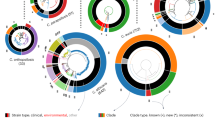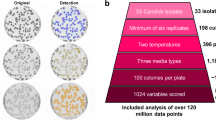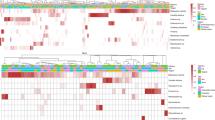Key Points
-
This review examines the genetic mechanisms that underlie fungal adhesion to surfaces. The authors propose a common mechanism for the generation of diversity among fungal adhesins. They suggest that amplification and contraction of the repeats found in the adhesin genes creates the diversity seen in these proteins. Adhesion is a key component of fungal virulence, so an understanding of fungal adhesion mechanisms is also medically important.
-
Saccharomyces cerevisiae is ideally suited to studying the structure and function of adhesin-family genes. There are five adhesin genes, known as FLO genes, in S. cerevisiae, although only one allele is usually expressed. The chromosomal locations of each of the FLO genes and the phenotypes associated with their overexpression are described.
-
Recombination within and between FLO genes can generate cell-surface diversity. Sequence motifs within each FLO gene are repeated so that recombination can occur between tandem repeats in a single adhesin gene or between different genes. Certain motifs are highly conserved and the authors suggest that one reason for this might be that recombination to generate surface-antigen diversity might provide a selective advantage.
-
Differential expression of the FLO alleles also contributes to cell-wall diversity. FLO11, the only FLO gene that is expressed in vegetative S. cerevisiae in vitro, is switched on and off by an epigenetic mechanism that involves chromatin-binding proteins. These are modulated through nutritional signals that are transmitted through mitogen-activated protein kinase and protein kinase A pathways.
-
It is not known how silent FLO genes become transcriptionally activated in vivo, but certain mutations can switch on the expression of these genes. This might also be a feature of Candida glabrata, which usually expresses only one of five adhesin genes. However, in Candida albicans a more complex system has been reported, in which more than one adhesin gene is expressed concurrently.
-
The authors discuss the roles that the adhesin loci of S. cerevisiae and Candida spp. have in the establishment and maintenance of fungal biofilms and in infection.
Abstract
The increase in hospital-acquired fungal infections has been attributed to the ability of fungi to adhere not only to human tissues, but also to the plastic prostheses and invasive devices that are used to treat disease. These properties are conferred by a family of fungal cell-surface proteins, called adhesins. Adhesins might also have a central role in the formation of fungal biofilms, which are resistant to antimicrobial drugs. The structure of the genes that encode adhesin-family members, and the sequence homology between them, enables genetic reshuffling of domains to form new genes. Coupled with epigenetic changes in gene expression, these genetic rearrangements provide a reservoir of cell-surface molecules with new functions.
This is a preview of subscription content, access via your institution
Access options
Subscribe to this journal
Receive 12 print issues and online access
$209.00 per year
only $17.42 per issue
Buy this article
- Purchase on Springer Link
- Instant access to full article PDF
Prices may be subject to local taxes which are calculated during checkout







Similar content being viewed by others
References
Hazen, K. C. New and emerging yeast pathogens. Clin. Microbiol. Rev. 8, 462–478 (1995).
Pfaller, M. A. et al. International surveillance of bloodstream infections due to Candida species: frequency of occurrence and in vitro susceptibilities to fluconazole, ravuconazole, and voriconazole of isolates collected from 1997 through 1999 in the SENTRY antimicrobial surveillance program. J. Clin. Microbiol. 39, 3254–3259 (2001).
Cassone, M. et al. Outbreak of Saccharomyces cerevisiae subtype boulardii fungemia in patients neighboring those treated with a probiotic preparation of the organism. J. Clin. Microbiol. 41, 5340–5343 (2003).
Douglas, L. J. Candida biofilms and their role in infection. Trends Microbiol. 11, 30–36 (2003). This paper and references 56 and 66 review the evidence for the formation of biofilms by Candida spp.
Richards, M. J., Edwards, J. R., Culver, D. H. & Gaynes, R. P. Nosocomial infections in medical intensive care units in the United States. Crit. Care Med. 27, 887–892 (1999).
Nguyen, M. H. et al. Therapeutic approaches in patients with candidemia. Arch. Intern. Med. 155, 2429–2435 (1995).
Baillie, G. S. & Douglas, L. J. Candida biofilms and their susceptibility to antifungal agents. Methods Enzymol. 310, 644–656 (1999).
Herre, J., Gordon, S. & Brown, G. D. Dectin-1 and its role in the recognition of β-glucans by macrophages. Mol. Immunol. 40, 869–876 (2004).
Taylor, P. R. et al. The role of SIGNR1 and the β-glucan receptor (Dectin-1) in the nonopsonic recognition of yeast by specific macrophages. J. Immunol. 172, 1157–1162 (2004).
Fraser, I. P., Koziel, H. & Ezekowitz, R. A. The serum mannose-binding protein and the macrophage mannose receptor are pattern recognition molecules that link innate and adaptive immunity. Semin. Immunol. 10, 363–372 (1999).
Guo, B., Styles, C. A., Feng, Q. & Fink, G. A Saccharomyces gene family involved in invasive growth, cell–cell adhesion, and mating. Proc. Natl Acad. Sci. USA 97, 12158–12163 (2000).
Hoyer, L. L. The ALS gene family of Candida albicans. Trends Microbiol. 9, 176–180 (2001).
Teunissen, A. W. R. H. & Steensma, H. Y. Review: the dominant flocculation genes of Saccharomyces cerevisiae constitute a new subtelomeric gene family. Yeast 11, 1001–1013 (1995).
Lo, W. S. & Dranginis, A. M. The cell surface flocculin Flo11 is required for pseudohyphae formation and invasion by Saccharomyces cerevisiae. Mol. Biol. Cell 9, 161–171 (1998).
Vyas, V. K., Kuchin, S., Berkey, C. D. & Carlson, M. Snf1 kinases with different β-subunit isoforms play distinct roles in regulating haploid invasive growth. Mol. Cell. Biol. 23, 1341–1348 (2003).
Reynolds, T. B. & Fink, G. R. Bakers' yeast, a model for fungal biofilm formation. Science 291, 878–881 (2001).
Gaur, N. K. & Klotz, S. A. Expression, cloning, and characterization of a Candida albicans gene, ALA1, that confers adherence properties upon Saccharomyces cerevisiae for extracellular matrix proteins. Infect. Immun. 65, 5289–5294 (1997).
Cormack, B. P., Ghori, N. & Falkow, S. An adhesin of the yeast pathogen Candida glabrata mediating adherence to human epithelial cells. Science 285, 578–582 (1999). A clever approach to cloning a key adhesin gene from Candida glabrata . The paper demonstrates the advantage of assessing the functions of Candida adhesin genes in Saccharomyces cerevisiae.
Li, F. & Palecek, S. P. EAP1, a Candida albicans gene involved in binding human epithelial cells. Eukaryot. Cell 2, 1266–1273 (2003).
Hazen, K. C., Brawner, D. L., Riesselman, M. H., Jutila, M. A. & Cutler, J. E. Differential adherence of hydrophobic and hydrophilic Candida albicans yeast cells to mouse tissues. Infect. Immun. 59, 907–912 (1991).
Green, C. B. et al. RT–PCR detection of Candida albicans ALS gene expression in the reconstituted human epithelium (RHE) model of oral candidiasis and in model biofilms. Microbiol. 150, 267–275 (2004).
Baillie, G. S. & Douglas, L. J. Role of dimorphism in the development of Candida albicans biofilms. J. Med. Microbiol. 48, 671–679 (1999).
De Las Penas, A. et al. Virulence-related surface glycoproteins in the yeast pathogen Candida glabrata are encoded in subtelomeric clusters and subject to RAP1- and SIR-dependent transcriptional silencing. Genes Dev. 17, 2245–2258 (2003).
Hoyer, L. L. et al. Characterization of agglutinin-like sequence genes from non-albicans Candida and phylogenetic analysis of the ALS family. Genetics 157, 1555–1567 (2001).
Zhang, N. et al. Sixty alleles of the ALS7 open reading frame in Candida albicans: ALS7 is a hypermutable contingency locus. J. Genome Res. 13, 2005–2017 (2003).
Zhao, X., Pujol, C., Soll, D. R. & Hoyer, L. L. Allelic variation in the contiguous loci encoding Candida albicans ALS5, ALS1 and ALS. Microbiology 149, 2947–2960 (2003). Shows that three of the Candida albicans adhesins are linked on chromosome 6 and that the two alleles for each gene have different numbers of repeats.
Halme, A., Bumgarner, S., Styles, C. A. & Fink, G. R. Genetic and epigenetic regulation of the FLO gene family generates cell-surface variation in yeast. Cell 116, 405–415 (2004).
Hoyer, L. L., Payne, T. L. & Hecht, J. E. Identification of Candida albicans ALS2 and ALS4 and localization of Als proteins to the fungal cell surface. J. Bacteriol. 180, 5334–5343 (1998).
Kobayashi, O., Hayashi, N., Kuroki, R. & Sone, H. Region of Flo1 proteins responsible for sugar recognition. J. Bacteriol. 180, 6503–6510 (1998).
Bony, M., Thines-Sempoux, D., Barre, P. & Blondin, B. Localization and cell surface anchoring of the Saccharomyces cerevisiae flocculation protein Flo1p. J. Bacteriol. 179, 4929–4936 (1997).
De Groot, P. W. J., Hellingwerf, K. J. & Klis, F. M. Genome-wide identification of fungal GPI proteins. Yeast 20, 781–796 (2003).
Frieman, M. B. & Cormack, B. P. The Ω-site sequence of glycosylphosphatidyl-inositol-anchored proteins in Saccharomyces cerevisiae can determine distribution between the membrane and the cell wall. Mol. Microbiol. 50, 883–896 (2003).
Udenfriend, S. & Kodukula, K. How glycosyl-phosphatidylinositol-anchored membrane proteins are made. Annu. Rev. Biochem. 64, 563–591 (1995).
Lu, C. F. et al. Glycosyl phosphatidylinositol-dependent cross-linking of α-agglutinin and β-1,6-glucan in the Saccharomyces cerevisiae cell wall. J. Cell. Biol. 128, 333–340 (1995).
Klis, F. M., Mol, P., Hellingwerf, K. & Brul, S. Dynamics of cell wall structure in Saccharomyces cerevisiae. FEMS Microbiol. Rev. 26, 239–256 (2002). Provides a superb guide to the molecular organization of the yeast cell wall.
Frieman, M. B., McCaffery, J. M. & Cormack, B. P. Modular domain structure in the Candida glabrata adhesin Epa1p, a β-1,6 glucan-cross-linked cell wall protein. Mol. Microbiol. 46, 479–492 (2002).
Liu, H. P., Styles, C. A. & Fink, G. R. Saccharomyces cerevisiae S288C has a mutation in FLO8, a gene required for filamentous growth. Genetics 144, 967–978 (1996).
Sundstrom, P. Adhesins in Candida albicans. Curr. Opin. Microbiol. 2, 353–357 (1999).
Gale, C. A. et al. Linkage of adhesion, filamentous growth, and virulence in Candida albicans to a single gene, INT1. Science 279, 1355–1358 (1998).
Staab, J. F. & Sundstrom, P. Genetic organization and sequence analysis of the hypha-specific cell wall protein gene HWP1 of Candida albican. Yeast 14, 681–686 (1998).
Staab, J. F., Bradway, S. D., Fidel, P. L. & Sundstrom, P. Adhesive and mammalian transglutaminase substrate properties of Candida albicans Hwp1. Science 283, 1535–1538 (1999). Describes a unique mechanism by which a Candida cell-wall protein might become linked to the surface of human cells.
Sohn, K., Urban, C., Brunner, H. & Rupp, S. EFG1 is a major regulator of cell wall dynamics in Candida albicans as revealed by DNA microarrays. Mol. Microbiol. 47, 89–102 (2003).
Fu, Y. et al. Expression of the Candida albicans gene ALS1 in Saccharomyces cerevisiae induces adherence to endothelial and epithelial cells. Infect. Immun. 66, 1783–1786 (1998).
Fu, Y. et al. Candida albicans Als1p: an adhesin that is a downstream effector of the EFG1 filamentation pathway. Mol. Microbiol. 44, 61–72 (2002).
Sheppard, D. C. et al. Functional and structural diversity in the Als protein family of Candida albicans. J. Biol. Chem. (in the press).
Pâques, F., Richard, G. -F. & Haber, J. E. Expansions and contractions in 36-bp minisatellites by gene conversion in yeast. Genetics 158, 155–166 (2001). An excellent analysis of specific mechanisms by which the number of repeats can be amplified or reduced.
Bishop, A. J. R., Louis, E. J. & Borts, R. H. Minisatellite variants generated in yeast meiosis involve DNA removal during gene conversion. Genetics 156, 7–20 (2000).
Sato, M., Watari, J. & Shinotsuka, K. Genetic instability in flocculation of bottom-fermenting yeast. J. Am. Soc. Brew. Chem. 59, 130–134 (2001).
Jibiki, M., Ishibiki, T., Yuuki, T. & Kagami, N. Application of polymerase chain reaction to determine the flocculation properties of brewer's lager yeast. J. Am. Soc. Brew. Chem. 59, 107–110 (2001).
Hoyer, L. L. & Hecht, J. E. The ALS5 gene of Candida albicans and analysis of the Als5p N-terminal domain. Yeast 18, 49–60 (2001).
Harrison, P. et al. A small reservoir of disabled ORFs in the yeast genome and its implications for the dynamics of proteome evolution. J. Mol. Biol. 316, 409–419 (2002).
Rupp, S., Summers, E., Lo, H. J., Madhani, H. & Fink, G. MAP kinase and cAMP filamentation signaling pathways converge on the unusually large promoter of the yeast FLO11 gene. EMBO J. 18, 1257–1269 (1999).
Serio, T. R. & Lindquist, S. L. [PSI+]: an epigenetic modulator of translation termination efficiency. Annu. Rev. Cell. Dev. Biol. 15, 661–703 (1999).
Eggimann, P. & Pittet, D. Overview of catheter-related infections with special emphasis on prevention based on educational programs. Clin. Microbiol. Infect. 8, 295–309 (2002).
Hawser, S. P. & Douglas, L. J. Biofilm formation by Candida species on the surface of catheter materials in vitro. Infect. Immun. 62, 915–921 (1994).
Chandra, J. et al. Biofilm formation by the fungal pathogen Candida albicans: development, architecture, and drug resistance. J. Bacteriol. 183, 5385–5394 (2001).
Sundstrom, P. Adhesion in Candida spp. Cell. Microbiol. 4, 461–469 (2002).
Hawser, S. P., Baillie, G. S. & Douglas, L. J. Production of extracellular matrix by Candida albicans biofilms. J. Med. Microbiol. 47, 253–256 (1998).
O'Toole, G., Kaplan, H. B. & Kolter, R. Biofilm formation as microbial development. Annu. Rev. Microbiol. 54, 49–79 (2000).
Davey, M. E. & O'Toole, G. A. Microbial biofilms: from ecology to molecular genetics. Microbiol. Mol. Biol. Rev. 64, 847–867 (2000).
Darby, C., Hsu, J. W., Ghori, N. S. & Falkow, S. Caenorhabditis elegans: plague bacteria biofilm blocks food intake. Nature 417, 243–244 (2002).
Mah, T. F. & O'Toole, G. A. Mechanisms of biofilm resistance to antimicrobial agents. Trends Microbiol. 9, 34–39 (2001).
Wingender, J., Strathmans, M., Rode, A., Leis, A. & Flemming, H. C. Isolation and biochemical characterization of extracellular polymeric substances from Pseudomonas aeruginosa. Methods Enzymol. 336, 302–314 (2001).
Martinez, A., Torello, S. & Kolter, R. Sliding motility in mycobacterium. J. Bacteriol. 181, 7331–7338 (1999).
Baillie, G. S. & Douglas, L. J. Matrix polymers of Candida biofilms and their possible role in biofilm resistance to antifungal agents. J. Antimicrob. Chemo. 46, 397–403 (2000).
Kumamoto, C. A. Candida biofilms. Curr. Opin. Microbiol. 5, 608–611 (2002).
Garcia-Sanchez, S. et al. Candida albicans biofilms: a developmental state associated with specific and stable gene expression patterns. Eukaryot. Cell 3, 536–545 (2004).
Kellis, M., Birren, B. W. & Lander, E. S. Proof and evolutionary analysis of ancient genome duplication in the yeast Saccharomyces cerevisiae. Nature 428, 617–624 (2004).
Bailey, T. L. & Elkan, C. Unsupervised learning of multiple motifs in biopolymers using expectation maximization. Mach. Learn. 21, 51–80 (1995).
Altschul, S. F. et al. Gapped BLAST and PSI-BLAST: a new generation of protein database search programs. Nucleic Acids Res. 25, 3389–3402 (1997).
Rice, P., Longden, I. & Bleasby, A. EMBOSS: the European molecular biology open software suite. Trends Genet. 16, 276–277 (2000).
Thompson, J. D., Higgins, D. G. & Gibson, T. J. CLUSTAL W: improving the sensitivity of progressive multiple sequence alignment through sequence weighting, position-specific gap penalties and weight matrix choice. Nucleic Acids Res. 22, 4673–4680 (1994).
Acknowledgements
The authors thank F. Lewitter for her assistance with sequence analysis and S. Bumgarner for valuable discussions and proofreading of the manuscript. K.J.V. is a D. Collen Fellow of the Belgian American Educational Foundation and a beneficiary of a long-term travel grant from the Fund for Scientific Research — Flanders (F.W.O. Vlaanderen). G.R.F. is an American Cancer Society Professor of Genetics. Research in G.R.F.'s laboratory was supported by a National Institutes of Health grant.
Author information
Authors and Affiliations
Corresponding author
Ethics declarations
Competing interests
The authors declare no competing financial interests.
Related links
Related links
DATABASES
SwissProt
FURTHER INFORMATION
Sequencing of Candida albicans at the Stanford Genome Technology Center
Glossary
- TELOMERES
-
The physical ends of linear chromosomes. They are associated with specialized nucleoprotein complexes that are required for the protection, replication and stabilization of the chromosome ends. In most organisms, telomeres contain many tandemly repeated DNA sequences called 'terminal repeats'.
- SUBTELOMERIC REGIONS
-
DNA sequences close to telomeres. Genes in these regions are often found in multiple copies on different chromosomes and might be subjected to common regulatory mechanisms as a consequence of their proximity to the telomeres.
- UNEQUAL CROSSOVER
-
A recombination event between DNA sequences that are not correctly aligned. This often occurs in repetitive sequences when the repeat units (DNA motifs) are paired out of register.
- MINISATELLITES
-
Also known as variable-number tandem repeats. These are DNA sequences of variable length that consist of many tandemly repeated DNA motifs of 5–35 base pairs. Minisatellite regions are unstable and often expand or contract during meiosis and mitosis, making them good targets for genotyping.
- PSEUDOHYPHAL GROWTH
-
A form of cell division that results in a filament of elongated cells. The pseudohyphal filament differs from a hypha because each member of the pseudohyphal filament is a distinct cell, whereas the hypha is a long, multi-nucleate filament without separate cells.
Rights and permissions
About this article
Cite this article
Verstrepen, K., Reynolds, T. & Fink, G. Origins of variation in the fungal cell surface. Nat Rev Microbiol 2, 533–540 (2004). https://doi.org/10.1038/nrmicro927
Issue Date:
DOI: https://doi.org/10.1038/nrmicro927
This article is cited by
-
Architecture of the dynamic fungal cell wall
Nature Reviews Microbiology (2023)
-
Transcriptomic and biochemical analyses revealed antifungal mechanism of trans-anethole on Aspergillus flavus growth
Applied Microbiology and Biotechnology (2023)
-
Permissive aggregative group formation favors coexistence between cooperators and defectors in yeast
The ISME Journal (2022)
-
The novel Dbl homology/BAR domain protein, MsgA, of Talaromyces marneffei regulates yeast morphogenesis during growth inside host cells
Scientific Reports (2021)
-
Comparative genomics reveals the origin of fungal hyphae and multicellularity
Nature Communications (2019)



